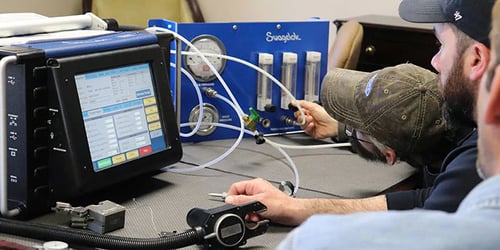Share this
Does Your Orbital Welding Training Include Troubleshooting Expertise?
by Morgan Zealear on 4/28/22 9:00 AM

Orbital welding enables industries to achieve difficult welds with ease, as compared to manual welding. It is relatively easy to achieve a large number of successful welds in less time with a few operators on the line. However, those few operators need to be well-trained to program, operate, and troubleshoot the orbital welding machine to consistently achieve quality results with respect to high purity standards. Therefore, training is essential to ensure operators have the knowledge to achieve these results.
When considering an orbital welding training partner, look for programs that not only teach operators how to program and use orbital welding machines but also focus on troubleshooting.
Let’s take a look at some of the common orbital welding challenges and how troubleshooting training can help mitigate them.
Troubleshooting Common Orbital Welding Challenges
Sulfur Content Mismatch
Sulfur content mismatch on both sides of the workpiece can cause improper welding, followed by a weld bead shift. Ideally, the weld bead should neither appear too concave nor convex after passivation. If it does, the sulfur content of the metal should be assessed. Maintaining adequate sulfur content is essential to providing consistent weldability without sacrificing metal purity.
If the system has female VCR fittings, it is imperative to run the nuts through anti-galling treatment to avoid contamination from acid during passivation. Swagelok’s removable split VCR nuts and VCR nuts with no silver and/or no lubricant allow you to passivate the workpiece without worrying about nut contamination.
An orbital welding training partner that also manufactures the components you need can help trainees troubleshoot with ease.
Weld Contamination
One of the major challenges for orbital welders is avoiding weld contamination as it can completely render a product useless. A grey haze or gritty appearance on the surface post welding confirms weld contamination. The workpiece may become contaminated due to various reasons, including insufficient inert gas coverage, presence of foreign matter, and high arc voltage, among others.
An ideal training course will educate trainees on how to ensure complete cleanness of the workpiece to avoid contamination in the first place. It will also help them understand how impurity in parent material can lead to contamination on the joint.
Errors in Amperage
Sometimes filler metal may fall out of the weld, and that can be due to an incorrect machine amperage. When the machine is too hot or too cold, the substrate of the workpiece fails to bond with the filler metal properly. Most of the time, this error in amperage is a human error. However, the external environmental temperature may sometimes affect the material prior to orbital welding.
The best way to minimize human error is to double-check the weld production schedule and power supply before starting the operation. Any loose connections can interrupt the healthy current flow.
An operator properly trained to troubleshoot will know which measures can be taken to tackle environmental disturbances, such as preheating the workpiece before welding, shielding the surface from heat sources, or timing the operation as per the environment.
Weld Cracking
Weld cracking is a common phenomenon while welding exotic metals like Inconel and monel. During cooling of the weld metal, if stress is induced due to a differential rate of contraction on the surface, it leads to cracks. These cracks can develop serious defects such as incomplete fusion, porosity, and longitudinal cracking. During orbital training, trainees should learn how to overcome such challenges by preheating the workpiece before welding and gradually cooling it down to remove any stress.
Tungsten Inclusion
For applications requiring high precision welding, tungsten entrapment is a common challenge. During welding, tungsten particles can separate and corrupt the weld pool under various circumstances. As a result, operators face discontinuity during the welding, and the process results in a weak joint formation.
Experts may suggest you control the current and gas flow rate and maintain a safe distance between the electrode and the workpiece to avoid inclusion. However, that may not work in every case. Instead, sharpening and polishing the tungsten electrodes during welding preparation may be a solution. Sharpening at the correct angle is necessary. Blunt electrodes are good at handling more amperage and achieving deep penetrations. But, if a consistent arc is required, sharp electrodes would do better.
The orbital welding challenges discussed above are not easy to handle without prior experience or proper training. Ensure your orbital welding training includes troubleshooting lessons to enable your associates to handle even the most critical situations with ease. Also, you should develop a good relationship with your orbital welding vendor to timely address any operational issues.
Your Local Orbital Welding Training Troubleshooting Partner
Swagelok has been offering quality solutions in fluid engineering for the last two decades. We also offer a five-day orbital welding training course to help refineries in Northern California experience accelerated output with well-trained employees on the line. Our orbital welding training includes troubleshooting activities where trainees learn how to handle critical situations through hands-on, live field experiments. And, our Field Engineers are always available to help you address any on-premise welding challenges on a single call.
With Swagelok, your employees benefit from bespoke orbital welding training from certified experts, helping to keep your operations running smoothly year after year.
To find out more about how Swagelok Northern California can help you with your orbital welding training, contact our team today by calling 510-933-6200.

About Morgan Zealear | Product Engineer, Assembly Services
Morgan holds a Bachelor of Science in Mechanical Engineering from the University of California at Santa Barbara. He is certified in Section IX, Grab Sample Panel Configuration, and Mechanical Efficiency Program Specification (API 682), and he is well versed in B31.3 Process Piping Code. Before joining Swagelok Northern, he was a manufacturing engineer at Sierra Instruments, primarily focused on capillary thermal meters for the semiconductor industry (ASML).
Share this
- Archive (465)
- Assembly Services (207)
- About (100)
- Seal Support Systems (96)
- Best Practices (88)
- Training Services (74)
- Fittings (51)
- Semiconductor Applications (49)
- Hoses and Flexible Tubing (47)
- Regulators (44)
- Tubing (42)
- Grab Sampling Systems (32)
- Sampling Systems (32)
- Gas Systems (30)
- Services (30)
- Downloads (29)
- Valves (24)
- Application Support (18)
- Orbital Welding (17)
- Case Studies (13)
- Steam Systems (13)
- Frequently Asked Questions (12)
- Tools (12)
- Measurement Devices (7)
- Subsystems (6)
- Thermal Management (6)
- September 2023 (1)
- August 2023 (2)
- June 2023 (1)
- March 2023 (3)
- February 2023 (3)
- January 2023 (4)
- December 2022 (4)
- November 2022 (4)
- October 2022 (4)
- September 2022 (1)
- August 2022 (3)
- July 2022 (2)
- June 2022 (4)
- May 2022 (1)
- April 2022 (2)
- March 2022 (1)
- February 2022 (2)
- January 2022 (3)
- December 2021 (1)
- November 2021 (6)
- October 2021 (6)
- September 2021 (8)
- August 2021 (4)
- July 2021 (3)
- June 2021 (6)
- May 2021 (6)
- April 2021 (7)
- March 2021 (5)
- February 2021 (4)
- January 2021 (6)
- December 2020 (5)
- November 2020 (6)
- October 2020 (6)
- September 2020 (8)
- August 2020 (7)
- July 2020 (8)
- June 2020 (8)
- May 2020 (6)
- April 2020 (9)
- March 2020 (7)
- February 2020 (10)
- January 2020 (21)
- December 2019 (23)
- November 2019 (21)
- October 2019 (22)
- September 2019 (21)
- August 2019 (22)
- July 2019 (23)
- June 2019 (20)
- May 2019 (23)
- April 2019 (22)
- March 2019 (21)
- February 2019 (20)
- January 2019 (21)
- December 2018 (14)
- November 2018 (19)
- October 2018 (23)
- September 2018 (17)
- August 2018 (29)
- July 2018 (11)
- June 2018 (6)
- May 2018 (5)
- April 2018 (4)
- March 2018 (5)
- February 2018 (3)
- January 2018 (3)
- December 2017 (2)
- November 2017 (4)
- October 2017 (3)
- September 2017 (2)
- August 2017 (6)
- July 2017 (4)
- June 2017 (4)
- May 2017 (4)
- April 2017 (3)
- March 2017 (4)
- February 2017 (3)
- January 2017 (3)
- December 2016 (3)
- November 2016 (3)
- October 2016 (3)
- September 2016 (5)
- August 2016 (5)
- July 2016 (4)
- June 2016 (5)
- May 2016 (3)
- April 2016 (4)
- March 2016 (5)
- February 2016 (11)
- January 2016 (1)
- December 2015 (3)
- November 2015 (4)
- October 2015 (3)
- September 2015 (4)
- August 2015 (4)
- July 2015 (8)
- June 2015 (5)
- May 2015 (3)
- April 2015 (4)
- March 2015 (4)
- February 2015 (3)
- January 2015 (4)
- December 2014 (2)
- November 2014 (3)
- October 2014 (4)
- September 2014 (4)
- August 2014 (4)
- July 2014 (5)
- June 2014 (4)
- May 2014 (4)
- April 2014 (5)
- March 2014 (4)
- February 2014 (3)
- January 2014 (4)
- December 2013 (5)
- November 2013 (3)
- October 2013 (4)
- September 2013 (3)
- August 2013 (5)
- July 2013 (5)
- June 2013 (5)
- May 2013 (3)
- April 2013 (6)
- March 2013 (4)
- February 2013 (4)
- January 2013 (8)
- December 2012 (4)
- November 2012 (6)
- October 2012 (6)
- September 2012 (4)
- August 2012 (4)
- July 2012 (4)
- June 2012 (4)

.webp?width=210&height=70&name=StickyLogo%20(5).webp)